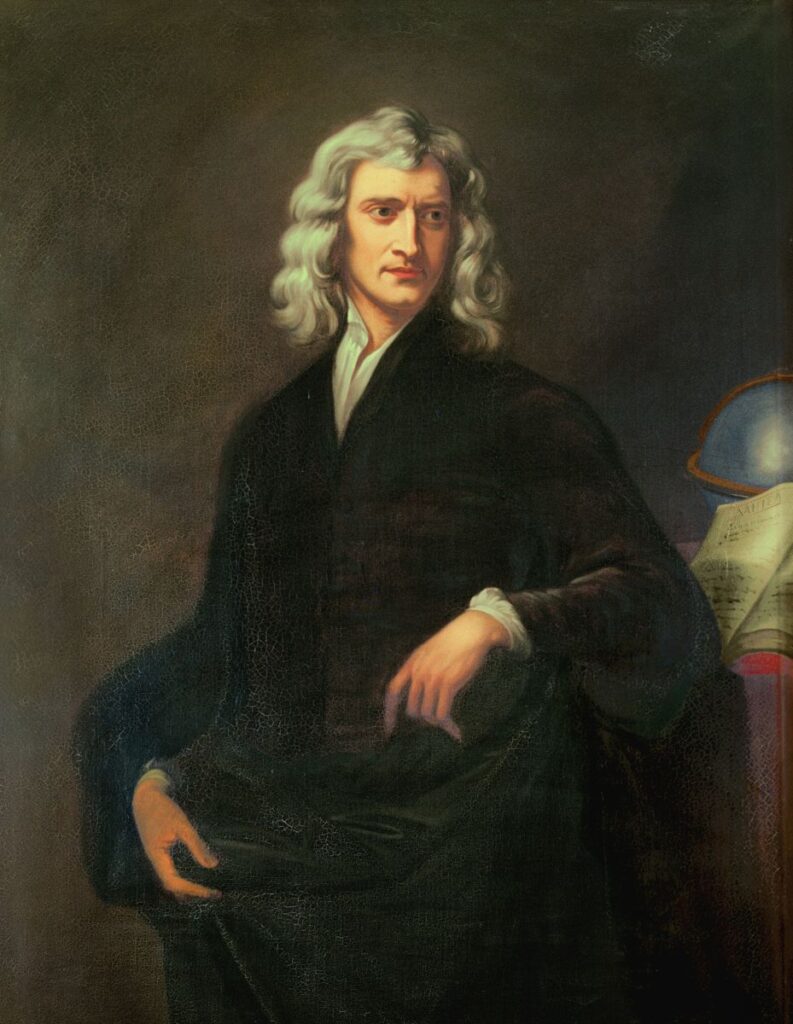British scientist and mathematician Sir Isaac Newton contributed substantially to the science of optics and the nature of light, formulated the laws of motion and gravitation, and independently developed a form of calculus.
Isaac Newton was born in Lincolnshire, England on January 4, 1643 (or December 25, 1642, by the Julian calendar then in use). Widowed shortly before Isaac’s birth, his mother remarried when he was three, leaving him to be raised by his grandmother. Believing Isaac should be a farmer like his father she sent him to a grammar school in Grantham. At the age of thirteen he returned home to run the family farm, but by 1661, his family decided that Isaac would never make a good farmer and sent him to Trinity College, University of Cambridge.
Newton received his BA degree from Trinity in January 1665 just as the bubonic plague was descending upon London. Cambridge University closed down on August 7, 1665, and encouraged its resident scholars to escape to the less densely populated countryside. Newton returned to his family’s farm until the university reopened in late 1666 after the plague had passed. After receiving his Master’s degree in 1668 he remained at Cambridge until 1687, teaching and developing theories in mathematics and physics. During this time he invented the branch of mathematics called infinitesimal calculus and identified many of the properties of light and optics. In 1668, Isaac Newton also built the first reflecting telescope, a major improvement on earlier designs.
Beset by emotional problems his entire life, and apparently afflicted by mercury poisoning due to his experiments in alchemy (the discredited pseudo-science centered on turning lead into gold), he suffered an emotional breakdown in 1678. By the next year, he had recovered enough to return to his research in celestial mechanics, as well as his less scientific pursuit of alchemy.
Many of Newton’s most significant contributions to physics and astronomy are in his masterpiece, the three-volume, “Philosophia Naturalis Principia Mathematica” (Mathematical Principals of Natural Philosophy), which he published in 1687 at his own expense. It contained his principle of universal gravitation, which explained both the motions of heavenly bodies and the falling of bodies on the earth. The Principia described Newton’s three laws of motion, fluid mechanics, the motions of the planets and their satellites, the motions of comets, and the phenomena of tides. In 1693, he suffered a second nervous breakdown. Although he recovered, his career as a scientist was over and he became more interested in political and economic matters.
Isaac Newton was appointed Warden of the British Mint in 1695, and in 1703, he was elected president of the Royal Society and was re-elected every year until his death. In 1704, he published another influential work, the Opticks, which detailed the revolutionary experiments he had conducted on the properties of light and matter decades earlier. In 1705, Queen Anne conferred Knighthood on Isaac Newton. Ironically he was honored for his political work, not his mathematical or scientific accomplishments.
Sir Isaac Newton died at Kensington, London on March 31, 1727, and was buried in Westminster Abbey, the first scientist to be accorded that honor. Asteroids 8000 Isaac Newton and 662 Newtonia are named in his honor, as is a crater on Mars. Asteroid 2653 Principia memorializes his monumental treatise, Philosophia Naturalis Principia Mathematica.
One of the most eccentric geniuses in history, Sir Isaac Newton has been credited with contributing more to the development of modern science than any other individual in history. He produced a model of the universe which was more consistent, elegant, and intuitive than any proposed before. The mathematical calculus he invented provided rules for dealing with rates of change and many astronomical calculations would have been impossible without it. The laws of gravity that Newton identified applied not only to the Earth but the entire known universe of the time. Newtonian Physics would remain the most valid means of understanding the universe until Albert Einstein’s Theory of Relativity two centuries later. Isaac Newton is also often credited with inventing the modern scientific method by refining Galileo’s experimental method, thus creating a modern scientific methodology.
Newton’s Three Laws of Motion:
1) Every object in a state of uniform motion tends to remain in that state of motion unless an external force is applied to it.
2) Unbalanced forces cause objects to accelerate with an acceleration that is directly proportional to the net force and inversely proportional to their mass.
3) For every action, there is an equal and opposite reaction.
Newton’s Law of Universal Gravitation:
-The force between any two bodies is directly proportional to the product of their masses and inversely proportional to the square of the distance between them. The constant of proportionality in this law is known as the gravitational constant.

